In the KNOW THE HEAT IS ON TO COOL THE PLANET.

A Quarterly Publication for Member Investors of the Sullivan County Partnership For Economic Development SUMMER 2023

Cooler and electric in 27 years? Maybe.
As we move into late summer, cooler-thannormal temperatures to start, a tornado, drenching thunderstorms, and smoke from Canadian wildfires are stark reminders, according to many, about climate change and the ensuing debates that come with it.
Like everything else in America, it’s a supercharged (no pun intended) issue fraught with extreme opinions. Science tells us that greenhouse gases, largely from fossil fuels, are causing the planet to heat up, and we need to curtail our use as soon as possible. Yet our economy and its success are tied directly to non-renewable energy in every way.
From the moment we wake each morning to when we lie down to sleep at night, we rely on some form of fossil fuel derivative to live and work. Our energy for transportation, heat, cooling, clothing, shoes, tires, pens, eyewear, and more comes wholly from or in part from fossil fuels. So, weaning off them entirely is unrealistic, at least in the immediate future.
Without a doubt, the issue is the big gorilla in the room— where it’s sourced, how we use it, and how we can make responsible use of it with alternatives, including wind, and solar hydrogen — fueling debate across the country and the globe.
In New York State, making the energy issue even more complicated is the New York Climate Leadership Community Protection Act. Government, as it often does, will try to force change through public policy rather than natural market evolution. Signed into law in 2019, the legislation calls on every New Yorker to play a role in reaching renewable energy benchmarks in 2030, 2040 and ultimately “net zero” emissions statewide by 2050.
The plan’s goals include achieving:
• 70% renewable electricity by 2030
• 100% zero-emission electricity by 2040
• 40% reduction in statewide GHG emissions from 1990 levels by 2030
• 85% reduction in statewide GHG emissions from 1990 levels by 2050
• Net zero emissions statewide by 2050
Now is the time to prepare for these upcoming changes, as it has already begun to impact how we go about business and our daily lives. The first benchmark comes in 2030—just seven years away. It will be here “in a blink of an eye.”
In this issue, you will read about the pros and cons of our push toward full electrification, electric vehicles, electrification of our homes and public spaces, challenges to meet public policy initiatives, passive buildings, and business opportunities that are growing from the substantial investments to meet climate action goals set forth by law.
How we adapt, influence change, and evolve will determine if we are winners or losers in this next major energy paradigm shift. This will impact everyone. With the information provided here, we hope we’ve offered some insight into how climate-focused up-and-coming changes can be addressed effectively.
Once again, a special thanks to our investors, advertisers, and content providers who help us make this one of the premier organizational publications in New York State. We hope to continue providing substantive information you can use in your business and daily lives. We appreciate your support.
Sincerely,
Marc Baez CEO


FROM THE
Sullivan County Partnership for Economic Development | 845.794.1110 | SCPartnership.com 3
CEO


Sullivan County Partnership for Economic Development In the Know | Summer 2023 4

Sullivan County Partnership for Economic Development | 845.794.1110 | SCPartnership.com 5
What the New York State Climate Leadership Community Protection Act means for New Yorkers: Insights from an Attorney

 By John C. Cappello, Esq., Partner (left) and Isabelle Hayes, Legal Intern (right) — J&G Law, LLP
By John C. Cappello, Esq., Partner (left) and Isabelle Hayes, Legal Intern (right) — J&G Law, LLP

Sullivan County Partnership for Economic Development In the Know | Summer 2023 6
The New York State Climate Leadership Community Protection Act (CLCPA) adopted in 2019 represents a concerted effort by the New York legislature to combat the effects of climate change.
The purpose of the CLCPA is to reduce greenhouse gas emissions and transition New York to a carbon-neutral economy by 2050. The Act sets ambitious targets, including an 85% reduction in greenhouse gas emissions from 1990 levels by 2050 and a 100% clean electricity target by 2040. Additionally, the CLCPA aims to create green jobs, promote environmental justice, and foster community engagement.
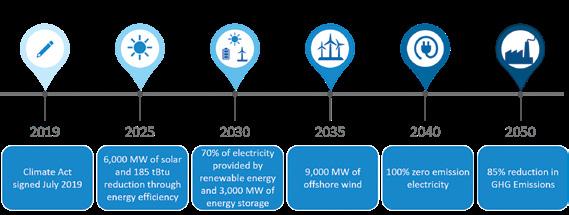
The state’s major electric and gas investor-owned utilities, for example, Central Hudson Gas & Electric, Orange & Rockland Utilities, Con-Ed, and NYSEG, collectively referred to as the “Utilities,” will be responsible for monitoring the state’s greenhouse gas emissions. The Utilities, at the direction of the Public Service Commission, and with the assistance by the Department of Public Services, created a proposal outlining the details for an annual Greenhouse Gas Emissions Inventory Report in which the Utilities would report on upstream, attributable, avoided, and end-user combustion emissions.
The CLCPA provides the New York State Department of Environmental Conservation (DEC) with the authority
to promulgate regulations, enforce compliance, and impose penalties for non-compliance. The DEC and the New York State Energy Research and Development Authority have recently conducted webinars to provide an overview of the potential program and are currently seeking to engage with stakeholders to obtain input on the details of the final program.
There is a wide range of opinions regarding the future impact and effectiveness of this Act. Some believe that it will have no impact whatsoever, while others argue that it will function as a mechanism to halt or delay all commercial development in New York State.
A chief concern of many opponents of the CLCPA is the fact that the Act encourages public participation and provides opportunities for citizens and community organizations to enforce compliance. While public involvement in the process is certainly important, the fear is that opponents to a specific development will seek to use the enforcement provision of the CLCPA as a tool to delay and frustrate legitimate well-designed and necessary development such as affordable housing projects and other job-creating tax-positive commercial projects.
Regardless of one’s standpoint, when it comes to legislation like the CLCPA, it is advisable for local governments to adopt a proactive approach. It is in their best interest to, first, review the substance of the Act and submit comments. They can do this by
Climate Act Targets
Source: https://nyrevconnect.com/climate-act/
continued... What the New York State Climate Leadership Community Protection Act means for New Yorkers: Insights from an Attorney
continued... Sullivan County Partnership for Economic Development | 845.794.1110 | SCPartnership.com 7
visiting the website www.capandinvest.ny.gov. Second, they can review their comprehensive plan to analyze and highlight a plan for compliance with the Act that focuses on their municipality, county, or region, rather than waiting until a specific project is presented, and then grappling with how the CLCPA aligns with the review process.
Issues to consider in any comprehensive review can include:
1. Compliance and Regulatory Frameworks:
The CLCPA mandates the establishment of a comprehensive regulatory framework, which includes developing emission limits, clean energy standards, and sector-specific regulations. Strategically positioning areas of concentrated development to enable the utilization of community water, sewer, and other services, while directing development towards easily accessible highway locations and imposing requirements for incorporating alternative energy sources like solar and geothermal, as well as state-of-the-art energy-saving features, will effectively highlight compliance with the CLCPA. Equally significant, having such a plan will offer a level of certainty in the process for prospective developers who wish to establish facilities within your community.

2. Environmental Justice and Equity:
The CLCPA places significant emphasis on environmental justice and ensuring an equitable distribution of the
advantages and drawbacks associated with environmental policies. Your strategy should incorporate an assessment that equitably distributes the compliance burden in a fair and impartial manner. It is essential to consider whether your plan facilitates the provision of diverse and affordable housing opportunities by allowing for an appropriate density of housing. It’s worth noting that while many may assume that denser housing automatically leads to increased greenhouse gas emissions, denser housing, when accompanied by community services in a walkable community, is often more environmentally protective than large single-family homes with individual well and septic systems.
3. Land Use and Infrastructure Development:
Accomplishing the goals set forth by the CLCPA requires substantial transformations in land use and infrastructure development. Your strategy should foster the growth of community solar projects, battery energy storage facilities, and enhanced sewer and water infrastructure to minimize wastage. Furthermore, it should prioritize energy conservation efforts and actively promote sustainable practices. Over the coming years, we can anticipate gaining a greater understanding of how the DEC and, subsequently, the New York State courts will manage the administration, interpretation, and enforcement of the CLCPA. Nevertheless, it is prudent to be well-prepared with a plan that may require slight adjustments in the future, rather than being caught off guard and unready.
What the New York State Climate Leadership Community Protection Act means for New Yorkers: Insights from an Attorney Sullivan County Partnership for Economic Development In the Know | Summer 2023 8
Explore. Innovate. Expand. With the fiber network built with your future in mind.
fiber networks are custom-built to meet your needs today, while preparing you for tomorrow’s most transformative innovations. So no matter what comes next, you’ll be ready—with the strength and assurance that come with working with an S&P 500 company.
pathway to possible. CrownCastle.com ©2023 Crown Castle CC-0323-091 Sullivan County Partnership for Economic Development | 845.794.1110 | SCPartnership.com 9
Our
The
Views from the Solar System
By Gerald J Skoda
On 9/11/2013 a fire destroyed the main barn on Skoda Farm. A new 40’ X 80’ pole barn was built in March of 2014, so what better time was there to consider putting a total farm solar system on that new roof?
A 17-kilowatt system was installed April 2017 by Noval Approaches Solar Applications LLC; Middletown NY. This was designed to produce all our electricity, including our house with a little to spare for the future.

The barn was perfectly situated for 100% solar production. Once the town code approvals were received, fifty-one solar panels were put on the roof and an inverter was put inside and hooked directly to our NYSEG power supply (no batteries to worry about).
There are several options for adding solar. One is ownership or it is possible to work with a company on a lease arrangement. The decision is based on economics. If you pay NYS and Federal Income Taxes ownership is the best route because the Tax Credits are substantial – (currently $10,000 Federal and $5,000 NYS). In addition, there is a NYSERDA grant and farm businesses in Sullivan County qualify for a USDA Rural Development grant of $10,000. Keep in mind if you lease, the lease company gets all these

Sullivan County Partnership for Economic Development In the Know | Summer 2023 10
benefits and all you get is the electric company generation monthly credit based on your production. Our net bottom line cost was $35,170 before tax credits and allowable depreciation (qualifies for 1 year write off as Business Bonus Depreciation). Our calculated payback is 6 years. There is also a 15-year exemption from real estate tax.
So, after 6 years what are the results? We have not paid a single cent for electricity in 6 years. NYSEG used to pay for excess production ($.03 per kw) but they got a Public Service Commission approval to not pay for excess power generated by small installations before we flipped the switch. However they do allow for excess to accumulate going forward (we currently have a full year’s credit if we did not produce another single KW)! We do pay NYSEG $17.90 per month for our service. Rosemary’s next car may be electric!
Other details:
• Maintenance: Zero to date
• Problems: Installer visited one time to check two roof leaks
• Panel life: 25 years – newer panels longer and more efficient


• Warranties: Vary by installer




Solar has been great for us and is a great option for farms that pay income taxes or can consider a large solar farm that requires some unused acres; located properly; near an electric company interface with excess capacity; and near 3 phase service. Solar farms are also popular as retirement income or for diversification but keep them off our good agricultural soils!

selling RELAX
THE TO US! Sullivan County Partnership for Economic Development | 845.794.1110 | SCPartnership.com 11
AND LEAVE








PO Box 4299, Middletown, NY 10941 | Yard/Shop: 21 Allen Lane, Bloomingburg, NY 12721 www.superior-surfacing.com ASPHALT CONTRACTORS and Related Construction Services Commercial Asphalt Paving & Repairs | Signage & Line Striping Crack Filling | Concrete Work | Excavation & Site Work Drainage | Sports Court Construction 845 . 733 . 5507 Sullivan County Partnership for Economic Development In the Know | Summer 2023 12


Sullivan County Partnership for Economic Development | 845.794.1110 | SCPartnership.com 13
Charging into a Cleaner Energy Future

The shift to EVs on New York’s roads means less tailpipe pollution locally and a reduction of greenhouse gas emissions that contribute to global climate change.
There are several reasons why electric vehicles (EVs) are experiencing a surge in popularity; heightened awareness about the negative impact of fossil fuels on the environment along with the availability of utility incentives and government tax rebates for EV owners. Advancements in battery technology have resulted in longer ranges and faster charging times, making EVs a more practical choice for many drivers.
Before making your EV purchase, it’s important to know that while now is the optimal time to buy, it can be daunting to choose which one is right for you if you’re unfamiliar with the EV realm.
Here’s a rundown of key information to take into consideration.
1. There are two types of EVs: battery electric vehicles (BEVs) and plug-in hybrid electric vehicles (PHEVs). BEVs operate solely on battery power and need to be charged frequently, while PHEVs run on both battery power and gasoline and can be fueled at gas stations.
2. Driving range. Most BEVs have a range between 100-400 miles on a single charge. It’s important to know how far you usually drive in a day to determine which range is suitable for you. If you have a long daily commute, a longer range is ideal. However, if you only drive short distances, a shorter range could save you money.
Sullivan County Partnership for Economic Development In the Know | Summer 2023 14
3. Availability of charging stations in your area. While charging technology has improved, the availability of charging stations is still limited in many parts of the country. Therefore, you need to ensure that charging stations are available in your area, so you can quickly and efficiently recharge your vehicle if needed.
4. Charging times. The charging time varies based on the range of the vehicle and the type of charger you are using. Level 1 charging requires only a standard household outlet and can take up to 24 hours to fully charge a battery. Level 2 chargers are faster and typically take four to six hours, while DC fast charging can take as little as 30 minutes to reach an 80% charge.
Orange and Rockland Utilities has taken the initiative to promote electric vehicle adoption by providing consumers with incentive programs that help make their transition to an EV seamless, and more affordable.
Under the PowerReady program, parties that install level 2 or direct-current fast chargers can offset some, or in certain cases, all the upfront infrastructure costs of preparing a site. Charging stations installed within a mile of disadvantaged communities qualify for the highest incentives. By facilitating this recharging technology, Orange & Rockland is encouraging drivers to take advantage of the benefits of driving an EV.
In addition to PowerReady, Orange & Rockland supports EV adoption through several other programs, including SmartCharge New York, which is a managed charging program that aims to reduce stress on the grid from EV charging. Drivers can earn unlimited cash incentives as a residential EV owner by charging at off-peak times in the service territory. This helps make service more reliable for everyone.
5. Maintenance. EVs have fewer moving parts than traditional gasoline-fueled vehicles, making them easier to maintain. There are typically fewer oil changes and other regular maintenance required in EVs. While the cost of the vehicle may be higher than traditional gas-fueled cars, they are cheaper to maintain over time, which offsets the higher initial cost.
While buying an EV may seem like a new and intimidating prospect, the benefits can outweigh any possible drawbacks. In addition to being environmentally friendly, they are also less expensive to maintain over time and offer a smoother driving experience.

Make sure you consider the driving range, availability of charging stations, type of charger, and ongoing maintenance when making your purchase. When you’re ready to lead the charge and switch to an EV, consider Orange & Rockland’s innovative EV incentive programs to make your transition to EV ownership that much easier by visiting oru.com/EV

Charging into a Cleaner Energy Future
Sullivan County Partnership for Economic Development | 845.794.1110 | SCPartnership.com 15
We are PowerReady
We’re accelerating the move toward electric vehicle ownership by connecting hundreds of new public and customer-owned charging stations through our PowerReady Program. Learn more at oru.com/PowerReady



incentives that cover up to 100% of the installation costs associated with installing Level 2 or DCFC stations at your commercial facility, multifamily building, or parking area. Sullivan County Partnership for Economic Development In the Know | Summer 2023 16
Get

Sullivan County Partnership for Economic Development | 845.794.1110 | SCPartnership.com 17
Uthman Aziz

NYSEG Government & Community Relations
How did you initially hear about the Partnership?
What made you want to get involved?
I learned about the Partnership through my colleague Melany Putman who was giving a presentation to the board years ago on some of the economic development incentives NYSEG offers. I continued to work with Marc and his team on NYSEG incentives and even had the opportunity to sponsor a few events held by the Partnership. I am honored to say that I am now a member of the Partnership’s Board and I continue to be amazed at the dedication and persistence Marc, Sue, Jen, and Vanessa have towards getting and keeping economic stability here in Sullivan County.
How did you get started with NYSEG?
I am currently a program manager in the Government and Community Relations Department of NYSEG’s Liberty Division, which includes Sullivan, Orange, and Ulster counties. I started in NYSEG’s contact center in Kirkwood NY 10 years ago as a call center representative. I progressed to becoming a call center supervisor and later a field supervisor in the meter department before getting into government and community relations. The knowledge gained from the various positions I have worked within NYSEG has uniquely equipped me with the tools needed to succeed in my current role.
What are your responsibilities at NYSEG?
During a storm situation, I am the lead public liaison for county emergency operations centers and the direct contact for municipalities. I work in coordination with our elected officials to address blocked roads, critical facility restoration, and constituent restoration. In my blue-sky role, I assist with customer service concerns whether they be bill or field- related. Additionally, I work with local non-profits helping them secure crucial sponsorships and donations from NYSEG. Within the last two years, NYSEG has increased their involvement in our communities by setting volunteering goals. The Liberty division has partnered with local organizations to assist with rail trail clean ups, food distribution, and local farm projects. I am very busy no matter which role I am working under but both roles provide me with a tremendous sense of satisfaction and honor to be working for a company like NYSEG.
What were some of the deciding factors for you to move your family to Sullivan County?
I was 15 years old when my family moved from Williamsport PA to Binghamton NY. So upstate NY has been home to me for over 25 years. Having the opportunity to work in Sullivan County has given me a chance to nurture my kids the way I was and allow them to grow up with an appreciation of their surroundings. I earned
Board Member Spotlight Q A
Sullivan County Partnership for Economic Development In the Know | Summer 2023 18
my master’s in public administration from Binghamton University, where I learned the importance of public service and I developed a love for non-profits and the crucial work they do. Sullivan County is also home to a multitude of non-profits and so I continue to be excited about the many partnerships I have the chance of establishing.
What are NYSEG’S priorities for our area of the Sullivan Catskills?
NYSEG’s priority is to provide safe and reliable electric and gas service across our entire service territory, which covers 40 percent of Upstate NY. Over the next few years, you can expect more automation and technology to be brought to the Liberty division, which includes parts of Sullivan County. We are expanding the use of smart fuses to minimize outage durations as well as animal guards to reduce the number of service interruptions caused by animal contacts. We also plan to replace poles with new, stronger ones, and increase tree trimming to identify and remediate hazardous trees inside and outside our rights-of-way.
With the climate action plan in place and the market push to electrification, ( i.e. EV/Heating systems for residential/commercial in full force) how is NYSEG preparing for this change?
NYSEG and RG&E have $247 million in funding planned over the next three years for energy efficiency and beneficial electrification programs such as electric heat pumps. We have plans for programs to enhance system capabilities and accommodate increased renewable resource utilization and grid updates such as transmission projects to support NY’s Climate Leadership and Community Protection Act.
How will it impact delivery/ prices/availability of energy?
We have worked for more than a year with stakeholders, including customer groups, industry, environmental interests, and the New York State Department of Public Service. More than eight parties have signed all or portions of the rate case settlement that
determines how the companies can best meet the needs of customers and New York State’s goals, while maintaining some of the lowest energy rates in the state. While the companies’ original proposal requested a 22 percent total increase, negotiations with the parties to the rate case resulted in compromises which will have lower impacts on customer bills. This proposed settlement provides the means to best serve customers considering historic inflation, the ongoing recovery from the COVID pandemic, supply chain issues, and new state requirements regarding clean energy. While the filing comes after years of minimal to no rate increases, RG&E and NYSEG have continued to make extensive and costly investments in the grid system to provide customers with reliable electric and gas service.
What is the plan and timetable for smart meters in our area? (And maybe you could explain what exactly the smart meters do.)
Smart meter installation is scheduled to begin in our Liberty division in December 2023 and run through April 2024. A smart meter is an electric and/or natural gas meter module with two-way communications between the meter and our systems. The smart meter transmits usage and meter status information to us. They securely enable detailed hourly usage information and meter status, so you can make more informed decisions to get the most out of your every energy dollar. They also will help us pinpoint and respond to outages more quickly.
Fun Facts: Hobbies
As a kid I loved bikes and the outdoors. I used to go camping and hiking in the Summer anytime I had the chance. Now as an adult, I still enjoy the outdoors, just more so in a golf cart. One of my secret loves is the game of chess, I just admire the game and how many ways/moves a player can make. I would be remiss if I did not mention the fanatical fandom, I have for all that is the Pittsburgh Steelers! We got Kenny Pickett after big Ben’s retirement and so I’m sure we will be back in the Super Bowl where we belong soon.
Sullivan County Partnership for Economic Development | 845.794.1110 | SCPartnership.com 19
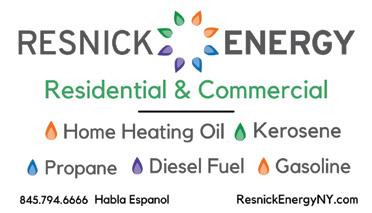




Asbestos Abatement Mold Remediation Wind & Storm Damage Your Trusted Restoration Partner Reconstruction Services 845-294-8919 Serving the entire Hudson Valley Water & Flood Damage Fire & Smoke Damage Delta provides an integrated set of professional design and support services to make your next project a success. We are your trusted partner. delta-eas.com IRT-1948J-A edwardjones.com Member SIPC John Leigh IV, CFP®, AAMS®, CRPC® Financial Advisor 46 Foster Road Suite #2 Hopewell Junction, NY 12533 845-227-5831 Sullivan County Partnership for Economic Development In the Know | Summer 2023 20
New York Energy Sector: Staying One Step Ahead of Cyber Threats
By Monique Duci, Meeting Tree Computer mduci@meetingtreecomputer.com
NY state has made substantial investments in renewable energy sources in recent years and with the integration of advanced technologies, such as energy storage systems and smart grid infrastructure, the grid’s ability to manage fluctuations in supply and demand has increased, providing greater flexibility and stability. However, as electric grids and other facilities in the energy supply chain are becoming more digitized and interconnected, the significance of cybersecurity cannot be overstated.
According to the Threat Intelligence Index report, energy companies in the US, incl. electric utilities and oil and gas companies, were the fourth-most attacked industry in 2022, costing the energy sector on average 4.72 million dollars per incident.
With the motive of causing major disruptions, nation-states, cyber attackers, and criminal organizations are pouring enormous resources and expertise into developing advanced techniques that exploit vulnerabilities in the chain’s digital infrastructure—knowing that the potential consequences of cyber threats will be severe and widespread as


power outages will disrupt essential services, cripple business and result in extensive financial losses.
And it’s not just the electric grid itself that faces these threats. While major hacks on the US energy supply chain, like the one against Colonial Pipeline, make for sensational headlines, local SMBs in the sector face equal, if not greater, risks. With budgets that include limited cybersecurity resources compared to their national counterparts, their digital infrastructures make attractive targets for hackers seeking to exploit human and network vulnerabilities.
Think of it this way, from a hacker’s point of view, why spend months (or sometimes years) trying to penetrate the robust security of a large national corporation when a local SMB or energy facility most likely has weaker defenses? Their return on investment can be equally lucrative when they add up the cumulative results from multiple successful attacks instead of one larger but much more complicated endeavor.
Protecting the energy supply chain and ensuring the continuity of local businesses is of paramount importance. As the chain becomes
more integrated with smart grid technologies, and decentralized energy generation, the opportunities for hackers to exploit potential weaknesses continue to grow. It is crucial we look to boost its cyber resilience and prevent potentially disastrous and far-reaching outcomes.
Recently NY state introduced Legislation A.3904B/S.5579A, providing guidelines that require utility companies and SMBs in the sector to secure their critical infrastructure against cyberattacks. How and what security measures you’re exactly meant to implement, it, unfortunately, doesn’t say. However, we suggest starting with a comprehensive assessment to help identify the vulnerabilities of your network. Once you do that, you can create a plan to mitigate those risks and implement security measures appropriate for your business.
Not an easy task, but we can help. We’d be happy to perform a free security assessment. If we find something we believe needs improvement, we’ll come back to you with a report and explain what and why. There’s no obligation to hire us to do the work. Ever.
Sullivan County Partnership for Economic Development | 845.794.1110 | SCPartnership.com 21
Sullivan County Partnership Grows
Clean Path New York is focused on solving complex challenges and meeting New York State’s ambitious climate goals. This $11 billion infrastructure project will enable the delivery of more than 7.5 million megawatt-hours of emissions-free energy into New York City every year, 100% of which will be generated in New York State. The project will meet New York State’s ambitious climate goals, create 8,300 jobs and save New York State ratepayers millions in energy costs in its first 25 years of operation. Clean Path NY gives all New Yorkers access to renewable energy from New York State and offers a solution to New York’s “Tale of Two Energy Grids.” Clean Path NY is a partnership between The New York Power Authority (NYPA), energyRe and Invenergy.
EXECUTIVE INVESTOR
The JPMorgan Chase Middle Market Banking & Specialized Industries provides credit, cash management, 401-k, international banking, capital markets and corporate finance solutions to public and private companies, municipalities and not-forprofit organizations.



Newburg Egg hatched in 1955 as a family-owned business, dedicated to providing the freshest eggs and egg ingredients. Over the years, Newburg Egg has expanded their products to include a full range of egg resources, without losing sight of their original purpose. They offer separated eggs, whole eggs, egg whites, egg yolks, egg substitute and scrambled egg mix, packed in small cartons as well as large scale buckets.

GOLD
Sullivan County Partnership for Economic Development In the Know | Summer 2023 22
INVESTOR
Colliers Engineering & Design, an affiliate of Colliers, is a trusted provider of multi-discipline engineering and architecture, design and consulting services to public and private sector clients. Headquartered in Holmdel, New Jersey with offices throughout the United States, they specialize in providing a comprehensive suite of services including civil/site, architecture, transportation, survey/geospatial, infrastructure, governmental, geotechnical/environmental, telecommunications, utilities/ energy and project management.

The Brothers that just do Gutters offer a wide variety of installations, cleaning and repairs in a small niche industry of seamless rain gutters and leaf guards. They have been able to grow the reliability of their services and offer only the best products by focusing all their effort on gutter systems and guards.


Domes at Catskills are a glamping adventure combining the experience of camping with the luxurious accommodations of a 5-star hotel. Their 10 domes welcome 2-4 guests, have heat, air conditioning, gas fireplace, kitchen, full bath, hot shower, and queen bed. Go enjoy the outdoor firepit, stroll along the private frontage on Swan Lake, or grill on the deck.

Generational Modular Group is a full-service design-build firm that specializes in prefabricated construction methods. Their approach is all-encompassing with a strict focus on client satisfaction. With three different service offerings including: general contracting, construction management, and owner’s representation services, they can provide their clients with value by creating a scope of work that meets their needs, expectations, and budget.

MDL Excavating Landscaping LLC provides an easy way to maintain your residential and commercial properties.

Whether you need trees removed or land cleared to start a commercial construction project, MDL Excavating Landscaping LLC has the team for the job. Located in Wurtsboro, NY, they proudly service all of Sullivan, Orange, and Ulster Counties.
Walden Savings Bank, established in 1872, is the 11th oldest federally chartered mutual savings bank headquartered in Montgomery, New York. With a total of 11 full-service branches serving the Hudson Valley region, and a lending office located in Beacon, NY, the Bank’s progressive style of community banking provides products that cater to both the individual and the growing mid-size business.
In 2018 Yasgur Road Productions LLC began planning a permanent campground which opened in 2020. The Yasgur Road Campground is located 90 miles from the greater New York metropolitan market and only 2 miles from the original site of the historic Woodstock Festival in Bethel, NY.

Welcome New Investors! To find out about how you can become involved as a member of the Partnership, contact Jen Cassaro at cassaro.jen@scpartnership.com Sullivan County Partnership for Economic Development | 845.794.1110 | SCPartnership.com 23
Solar Development and Energy Efficiency:
Illuminating New York State’s Sustainable Future
By John Saraceno Jr. Sustainability Manager, LEED GA KEYSTONE ASSOCIATES
New York State is at the forefront of renewable energy transformation, with a keen focus on solar development and energy efficiency.

As the state aims to achieve its ambitious clean energy targets and reduce its carbon footprint, solar power has emerged as a crucial component of its sustainable future. Let’s delve into the progress, benefits, and initiatives driving solar development and energy efficiency in New York, highlighting the state’s commitment to a greener and more resilient energy landscape.
Solar energy has gained significant momentum in New York State, supported by robust policies and incentives. The state’s NY-Sun Initiative has been instrumental in facilitating the expansion of solar. With the goal of quadrupling the amount of solar power installed by 2023, the initiative has encouraged residential, commercial, and community solar projects through financial incentives and streamlined permitting processes.
Furthermore, the Value of Distributed Energy Resources (VDER) tariff structure ensures fair compensation for solar producers, making solar installations economically viable.
Sullivan County Partnership for Economic Development In the Know | Summer 2023 24
New York State is equally committed to promoting energy efficiency to reduce overall energy consumption and carbon emissions. The New York State Energy Research and Development Authority (NYSERDA) plays a vital role in implementing energy efficiency programs, offering financial incentives to businesses, institutions, and homeowners. Moreover, New York State focuses on improving energy efficiency in new and existing buildings through energy audits, retrofits, and the adoption of advanced technologies.
The efforts invested in solar development and energy efficiency in New York State have resulted in substantial benefits and positive impacts. First and foremost, increased solar installations contribute to a diversified energy mix, reducing the state’s dependence on fossil fuels and enhancing energy security. Solar energy also helps mitigate greenhouse gas emissions and improve air quality.
Energy efficiency measures, on the other hand, lower energy bills for consumers and reduce the strain on the electric grid during peak demand periods. By reducing energy consumption, energy efficiency initiatives directly contribute to reducing greenhouse gas emissions, fostering environmental sustainability.


New York State’s commitment to solar development and energy efficiency is transforming its energy landscape, paving the way for a cleaner and more resilient future. Through initiatives like NY-Sun and the numerous New York State Energy Research and Development Authority (NYSERDA) programs, the state is leading by example and inspiring other regions to prioritize renewable energy and sustainability.
New York State Installed Solar Capacity by County - https://nysolarmap.com/
Keystone Associates Architects, Engineers and Surveyors, LLC is multi-disciplined design firm that includes Sustainability Management services in its wheelhouse. These Sustainability Management services include Sustainable Design Studies, Funding/Grant Application Services and Sustainability Management Planning. These services will determine which renewable energy options are right for your specific needs, identify all associated incentives available to reduce costs and increase your return on investment and set forth a plan of operation to ensure your sustainability goals are met for years to come.

Solar Development and Energy Efficiency: Illuminating New York State’s Sustainable Future
New York State Clean Energy Standard (CES) – Energy Goals
Sullivan County Partnership for Economic Development | 845.794.1110 | SCPartnership.com 25





FIND THE TALENT YOU NEED 845.344.3434 Matching candidates with real opportunities Did You Miss Advertising in this Issue or Would Like to Submit Editorial Content? Our next issue is scheduled for publication in December, and there is a considerable discount if you purchase an ad now for the following four issues. Contact Jen Cassaro at cassaro.jen@scpartnership.com today to find out how to reserve your spot in our Fall issue. In the KNOW THE HEAT IS ON TO COOL THE PLANET. A Quarterly Publication for Member Investors of the Sullivan County Partnership For Economic Development SUMMER 2023 Karen Fisher, Chair Michael Zalkin, Vice Chair James Bates, Treasurer Steven Vegliante, Secretary Board of Directors Uthman Aziz John Brust Jerry Dunleavy Amanda Gesztesi Carlito Holt Kelsey Hornicek Brittany Johnson George Kinne Kevin McLaren Gary Schmidt Gary Silver Gerald Skoda Fred Stabbert Charlotte Van Horn Larry Wolinsky Sullivan County Partnership for Economic Development In the Know | Summer 2023 26


Sullivan County Partnership for Economic Development | 845.794.1110 | SCPartnership.com 27
Livingston Farm – A Catalyst for Change
Livingston Farm, a mixed-use development located in Livingston Manor in the Catskills region of New York, is poised to become a shining example of sustainable and regenerative community design.

The project aligns seamlessly with New York State’s ambitious Climate Action Plan, incorporating various strategies to mitigate climate change and promote environmental stewardship, revolutionizing the way communities are developed in a rapidly changing world.
Livingston Farm is targeting LEED-ND (Leadership in Energy and Environmental Design for Neighborhood Development) certification which ensures that the entire development is built with sustainability in mind, encompassing not just individual buildings but also the surrounding infrastructure and public spaces, creating a cohesive and interconnected community that minimizes environmental impact while maximizing quality of life for its residents.
To achieve net-zero energy and passive building standards, Livingston Farm incorporates cutting-edge technologies and design principles. Buildings will be constructed to be highly energy-efficient, utilizing natural insulation, advanced glazing, and ventilation systems to reduce the need for heating and cooling. Off-site modular construction methods will be employed to minimize disturbance and waste, ensuring that the construction process itself is sustainable and efficient.
A key aspect of Livingston Farm’s commitment to regenerative practices is the use of carbon sinking building materials. This involves sourcing materials from on-site or local sources that have a minimal carbon footprint. By utilizing materials that store carbon, such
Sullivan County Partnership for Economic Development In the Know | Summer 2023 28
as sustainably harvested wood or recycled materials, the development will actively contribute to carbon sequestration, helping to combat climate change.

Regenerative agriculture practices such as cover cropping, rotational grazing, and agroforestry, aim to improve soil organic matter, reduce runoff, and enhance drought resilience. This approach not only benefits the local environment but also supports the local food system and promotes a sense of community engagement through educational programming.
Renewable energy plays a vital role in Livingston Farm’s commitment to a carbon-neutral future. The development will integrate solar panels, geothermal systems, wind turbines, and biomass energy generation to meet its energy needs sustainably, reducing its dependence on fossil fuels and contributing to the overall decarbonization of the region.
Addressing building emissions is another priority for Livingston Farm, which explores innovative solutions, such as direct air capture technology, to actively remove carbon dioxide from the atmosphere and is targeting carbon-negative status, further supporting the State’s objectives.
In line with its commitment to clean transportation, Livingston Farm includes various initiatives to promote sustainable mobility. Electric vehicle (EV) charging stations are strategically located throughout the community, encouraging the adoption of electric cars, and reducing emissions from transportation. An e-bike sharing network provides an alternative mode of transportation, promoting health, reducing traffic congestion, and minimizing environmental impact. Additionally, a shuttle and ride-sharing service will cater to the visitors’ transportation needs, further reducing the reliance on individual vehicles.
Livingston Farm represents a bold vision for sustainable and regenerative community development exemplifying the goals laid out in New York State’s Climate Action Plan. It sets a new standard for sustainable living, showcasing how communities can be built in harmony with nature while addressing the urgent need to combat climate change. Livingston Farm is not just a development; it is a catalyst for change, inspiring future projects and demonstrating the potential for a sustainable and regenerative future.
Livingston Farm is currently undergoing an environmental impact review.
Livingston Farm – A Catalyst for Change
Sullivan County Partnership for Economic Development | 845.794.1110 | SCPartnership.com 29


Sullivan County Partnership for Economic Development In the Know | Summer 2023 30
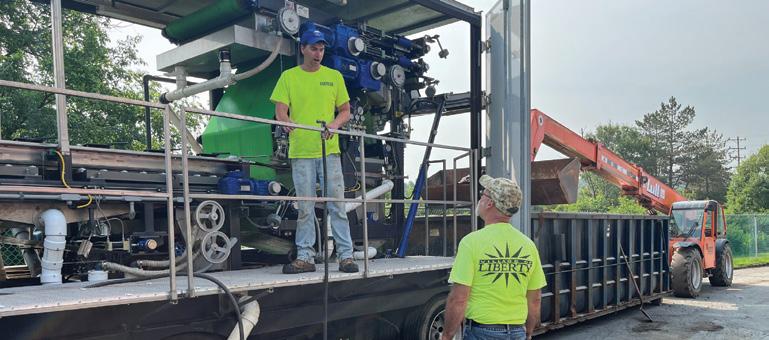
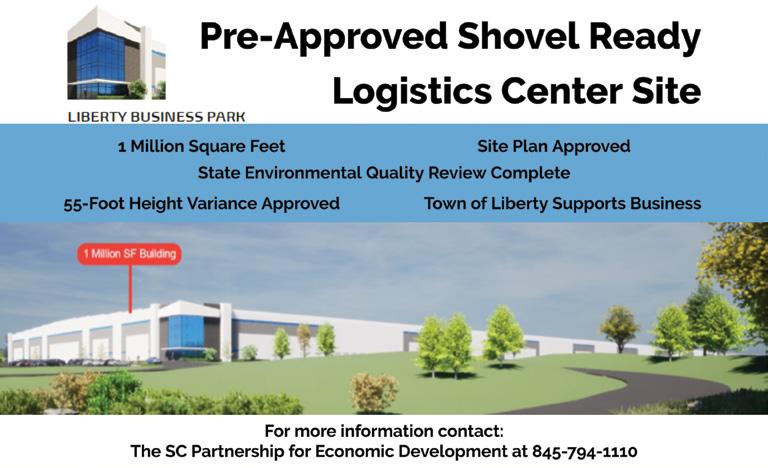
Delaware Engineering, D.P.C. Civil and Environmental Engineering Office Locations: Albany, Goshen, Monticello, Oneonta, Red Hook and Port Chester. Contact us at 518.452.1290 / info@delawareengineering.com The Village or Liberty receives a portable belt press to process wastewater sludge while they prepare to install a new permanent press for improved sludge de-watering. Explore our work at DelawareEngineering.com Sullivan County Partnership for Economic Development | 845.794.1110 | SCPartnership.com 31
CP-49 and the Energy Sector –
What You Need to Know
by James S. Arrabito, Esq., Catania, Mahon & Rider, PLLC

The Climate Leadership and Community Protection Act of 2019 represents a groundbreaking commitment by the State of New York to combatting climate change. Among other things, the CLCPA sets robust benchmarks for greenhouse gas (“GHG”) emissions reduction and conversion to renewable energies. Additionally, Section 7(2) of the CLCPA requires agencies to consider consistency with the Act’s goals prior to issuance of permits, licenses, and grants and execution of agreements. Agencies must also consider so-called “upstream” emissions associated with either (1) the generation of energy imported into the state; or (2) the extraction and importation of fossil fuels into New York from out of state.

As noted in the Climate Action Council’s Scoping Plan, until NYSDEC promulgates regulations to develop a holistic compliance regime, NYSDEC will gauge compliance with the CLPCA’s mandates with reference to the statewide GHG limits set forth in the Act. Thus, in December 2022, NYSDEC issued a revised Commissioner
Policy No. 49 (“CP-49”), setting forth NYSDEC policy for considering CLCPA consistency in permitting actions. CP-49 is applicable to several NYSDEC permitting programs, including SPDES and Air Pollution Control, and Solid Waste Management. Crucially, CP-49 is also expressly applicable to new and renewed approvals, permits, licenses, and agreements relating to “projects involving construction of energy production, generation, transmission, or storage facilities.” In the policy, NYSDEC set forth a “fact sensitive” inquiry to be performed in reviewing CLCPA consistency. That inquiry includes, but is not limited to: whether the proposed action will enable a new GHG emission source; whether the proposed action will or reasonably may increase a source’s permitted or expected GHG emissions; whether the proposed action will allow “a reasonably expected increase in actual GHG emissions above levels that existed prior to a permit application or decision at issue”; whether the proposed action fails to conform with the Scoping Plan or relevant NYSDEC regulations; whether the project would “be directly responsible
Sullivan County Partnership for Economic Development In the Know | Summer 2023 32
for an increase in demand for the use of a known source of GHG emissions”; whether the proposed action will directly reduce demand or access to GHG emissions-reducing technologies; and whether the proposed action will inhibit in any way the State’s ability to reduce GHG emissions overall.
Participants in the State’s energy markets should familiarize themselves with NYSDEC’s fact-sensitive inquiry. As part of the State’s holistic approach to addressing climate change impacts, the Act requires that 70% of statewide electricity come from renewable sources by 2030 and 100% by 2040. The State also set benchmarks for development of 10,000 MW of distributed solar generation and 6,000 MW of energy storage by 2030. Considering those goals, the transition from fossil-burning energy production to renewables will be a significant focus for industry participants in the coming decade and will present unique challenges for energy projects. Accordingly, as implementation
of the CLCPA and the Scoping Plan becomes a reality, and as the focus begins to turn to retirement and repurposing of existing fossil-burning baseload and peaking facilities, for example, energy projects will need to be planned with the CP-49’s considerations in mind and be able to respond to NYSDEC’s fact-sensitive inquiry at the application or renewal stage, as applicable. And, importantly, applicants will need to bear in mind that is not only a question of direct GHG emissions caused by the permitted action; the CLCPA takes a broader view, looking to upstream emissions, as well as potential in-state ripple effects that may indirectly be caused by an energy project. Similarly, the Scoping Plan provides that fossil-burning infrastructure may be repowered for reliability purposes under certain limited circumstances. Even there, the Scoping Plan requires compliance with Section 7(2) and, accordingly, applicants for NYSDEC approvals will need to ensure that repowering such facilities will contribute to the CLCPA’s GHG emissions-reduction goals.

Sullivan County Partnership for Economic Development | 845.794.1110 | SCPartnership.com 33
The Benefits of Passive House Construction
 By Justin DePhillips, Generational Modular Group
By Justin DePhillips, Generational Modular Group
Passive house construction is an innovative approach to building homes that prioritizes energy efficiency and sustainability. By utilizing advanced building techniques, passive homes offer numerous benefits to both their owners and the environment.
ADVANTAGES :
1. Reduced Energy Consumption:
One of the primary benefits of passive house construction is its ability to drastically reduce energy consumption. By prioritizing simple design principles, such as optimal insulation and airtightness, passive houses minimize heat loss during winter and heat gain during summer. This results in reduced reliance on heating and cooling systems, which leads to significant energy savings. The Passive House Institute estimates that passive houses consume up to 90% less energy for heating compared to conventional buildings.
2. Improved Indoor Air Quality:
Passive houses prioritize the health and well-being of occupants by incorporating efficient ventilation systems. These systems ensure a consistent supply of fresh air while effectively filtering out pollutants and allergens. Maintaining a balanced indoor environment enables passive houses to create better indoor air quality which can reduce the risk of respiratory issues and allergies.
About Generational Modular Group, LLC:
3. Long-Term Cost Savings:
While the initial cost of constructing a passive house will be higher than that of a “conventional” building, the long-term cost savings make it a worthwhile investment. The reduced energy consumption leads to lower utility bills, resulting in substantial savings over time. Additionally, passive houses require minimal maintenance due to their high-quality construction materials and design. This further reduces long-term costs associated with repairs and replacements.
Passive house construction offers numerous benefits, including, but not limited to, reduced energy consumption and long-term cost savings. By prioritizing energy efficiency and sustainability, passive houses aim to create a greener future while providing comfortable and healthy living spaces. As demand for smart, sustainable housing grows, passive house construction, in my opinion, offers the most promising solution to address both environmental and human needs.
Generational Modular Group is a full-service design-build firm that specializes in prefabricated construction methods. Our approach is all-encompassing with a strict focus on client satisfaction. With three different service offerings including: general contracting, construction management, and owner’s representation services, we can provide our clients with value by creating a scope of work that meets their needs, expectations, and budget.
Sullivan County Partnership for Economic Development In the Know | Summer 2023 34







2713 Route 17M . New Hampton, NY 10958 Kitchens . Baths . Closets O: (845) 615-9410 www.HVKDC.com Over 125 years of design experience! Civil & Site Planning | SEQR Environmental Assessments & Phase I and Phase II ESAs Wetland Delineations & T&E Studies | Geotechnical Engineering | Structural Engineering | Surveying Mapping & Construction Stakeout | 3D Lidar Scanning | Special Inspections and Materials Testing Proudly Serving the Region for over 36 years Mountainville, NY 800.829.6532 www.tectonicengineering.com 914-428-0010 • dtsprovident com Sullivan County Partnership for Economic Development | 845.794.1110 | SCPartnership.com 35
Sustainable Design for the Livable Future
By James Hartford, River Architects
The reality of climate change is now undeniable, and the risks it creates are affecting our communities in ways many of us found inconceivable just a few years ago. We have gone from a severe drought last year to a season of devastating, back-to-back “1,000-year” rain events, even while smoke from Canada’s wildfires compromises the air we breathe. Last year’s tapped-out wells and this year’s floods and wildfires have more than record-breaking heat in common: They fit precisely into the patterns predicted by climate-analysis models looking at the effects of carbon dioxide emissions from our fossil fuel use.
Hudson Valley–based River Architects, PLLC, designed the Seminary Hill Cidery in Callicoon—the world’s first certified Passive House cidery. Incorporating energy efficiency and all-electric equipment, the architecture successfully responds to the business owners’ goal to create and operate a beautiful, comfortable, and climate-responsible building at the heart of a holistic orchard and cidery. Seminary Hill Cidery has quickly become known as a well-respected local employer, popular gathering spot, and sought-after special events venue.
 Photo credit: Brad Dixon
Photo credit: Brad Dixon
Sullivan County Partnership for Economic Development In the Know | Summer 2023 36
All the evidence points to that the effects of climate change are upon us now- not in the distant “our grandchildren’s time” as was the old prediction. And while people today are beginning to feel the harm, we are currently still on the path to making the planet uninhabitable for future generations. Businesses and families alike need to plan for better survivability and
comfort in more extreme weather, while not contributing to the root cause of climate change by emitting more carbon into the atmosphere.
This reality drives what we do in our architecture on two fronts. First, to the fullest extent possible, we design and retrofit buildings that avoid contributing to carbon emissions. Second, we strive to create healthy, resilient buildings that are capable of weathering dangerous weather extremes, power outages, and poor air quality. Both essential motivations are met in the building standards we embrace with Passive House design and construction. At River Architects, we believe Passive House design and building standards offer the best available solutions to creating residential and commercial structures for the livable future. There are added costs in planning and building for an uncertain future. But it must also be said that it is fiscally irresponsible for individuals and businesses to continue building as if things will settle back into more predictable patterns- change is the new normal. It is core to our mission to design buildings that offer stability during disruption, safety during power outages, and solutions to escalating energy prices. Finally, we make sustainable buildings that are healthy for their inhabitants, and also beautiful and welcoming, knowing these are the ones destined to become places that people will care about today and for generations to come.


Sustainable Design for the Livable Future
River Architects designed the upcoming replacement of the Town of Bethel Town Hall as a certified Passive House structure, embodying the town’s commitment to becoming a Carbon Neutral Community. Soon to follow is a new 20,000-square-foot, carbon-neutral municipal garage that will operate entirely without fossil fuels and is planning for the transition of trucks away from diesel to electricity and clean hydrogen.
River Architects raised a flood-stricken structure and expanded on it to make Main Street office and café spaces in Livingston Manor. Our community-minded clients, for whom we designed the LEED Gold Catskill Brewery nearby, are glad to offer public access along the Willowemoc through their site for the future River Walk.
Image ©River Architects
Sullivan County Partnership for Economic Development | 845.794.1110 | SCPartnership.com 37
Image ©River Architects
How Moving to Clean Energy Can Save...


(or even make) You Money
The developers of over $10 Billion of new construction in Westchester were staggered when ConEdison announced the moratorium against new natural gas hookups in 2019. Since then, residential, multi-family, mixed use and commercial property developers have discovered that it is not only possible to construct buildings using only clean heating technologies – but they are often able to reduce their upfront capital costs by taking advantage of generous cash and tax incentives; simultaneously lowering their operating expenses and increasing property values, providing greater financing leverage and resale profitability.
The costs for energy efficiency, solar, heat pumps, electric vehicles and EV charging station technologies keep coming down, costing dramatically less to operate and are not subject to the volatility and ever-increasing price of fossil fuels.
 By Ron Kamen Earth Kind Energy Consulting
By Ron Kamen Earth Kind Energy Consulting
(Not to mention the positive marketing impacts of having healthier and more sustainable buildings, or the proud legacy they are creating for their children and grandchildren.)
Sullivan County Partnership for Economic Development In the Know | Summer 2023 38
With federal, state, and utility incentives, you can now buy many electric cars (EV = Electric Vehicle) for less upfront cost than a comparable gas car. But an EV costs 50-75% less per mile for fuel, and has dramatically less maintenance (an EV has ~20 moving parts vs. 2,000 in a combustion vehicle, and EVs have no oil or transmission fluids to change).
EarthKind advises all our clients to take advantage of the incentives now or pay penalties later. Starting in 2024, larger NYC property owners who don’t meet the carbon reduction goals will begin paying annual penalties (many that equate to ~50c per square foot.) Simultaneously, the NYS Climate Law (the “Climate Leadership & Community Protection Act”) is moving all of New York State in the same direction.
One example - EarthKind secured over $500k in clean energy cash grants and tax incentives for 2 mixed use projects just completed by Young Companies and Castle Rock Construction in New Rochelle. The 292 residential units and multiple retail stores in the Rockwell and Illustrator buildings will now have high-efficiency air source heat pumps for their HVAC needs, as well as solar electricity on the roofs, and EV charging stations in the parking lots.
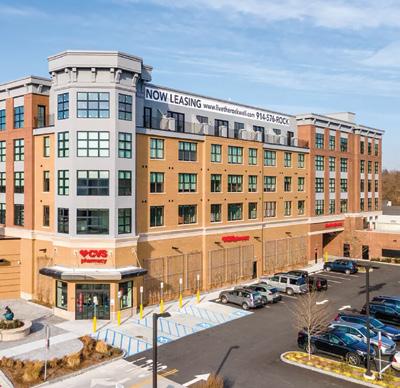
Solar provides an incredible opportunity for many property owners. In addition to ROIs of 20-90+%, EarthKind has represented property owners to secure solar for 100% of their annual electricity consumption with zero cash outlay, and both immediate and long-term utility savings.
With zero cash outlay via an EarthKind-negotiated Power Purchase Agreement, the Oakwood Friends School in Poughkeepsie is saving $30,000+ per year with 700KW of solar on ~3 acres of unused land www.oakwoodfriends.org/why-oakwood/going-green Hosting a community solar system on your roof or property can generate either annual lease payments or upfront cash for property improvements. By hosting a community solar system on their roof, the Consulate on the Park condo association in the Village of Tuckahoe, NY will be receiving enough cash from the solar company to pay for a new roof. AND – every resident will now have the option to sign up for a 10% reduction in their electricity costs. www.consulateonthepark.org
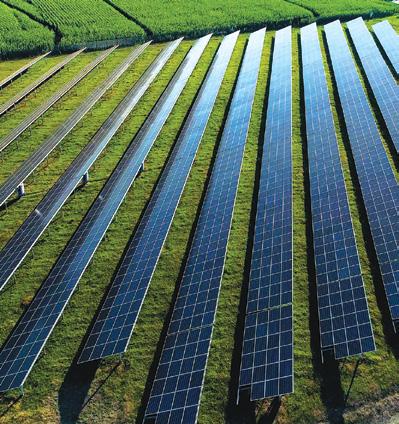
How Moving to Clean Energy Can Save (or even Make) You Money
continued... Sullivan County Partnership for Economic Development | 845.794.1110 | SCPartnership.com 39
What is a “heat pump?” You already own several of them. A refrigerator and freezer are heat pumps, as are air conditioners. The difference between an air conditioner and an air source heat pump is that the former only takes heat out of your space in the summer, while an air source heat pump does the same AND reverses the compression/expansion process to put heat inside during the winter. While heat pumps have been used for
decades in southern climates, technological advances now provide cold climate heat pumps that work down to -15 degrees. A heat pump costs about half as much to run as a natural gas or electric furnace, and about one-third as much as an oil or propane furnace. With the various incentives, heat pump installations can cost the same as a conventional furnace and substantially less than installing a high-efficiency furnace.

To hear some Hudson Valley Case Studies, including incentives that produced 10%-75% ROI, check out the 30-minute recording of EarthKind’s presentation at the Business Council of Westchester’s annual energy conference. “Making Green by Going Clean” provides concrete examples of solar, air & ground source heat pumps, EVs & charging stations. tinyurl.com/BCW-EarthKind

The presentation reviews projects that are CASH FLOW
POSITIVE from Day 1, with Immediate & Long-Term Savings via Traditional & Low-Cost Financing, Power Purchase Agreements, and/or Leases, including ZERO CASH DOWN, Public-Private Partnerships. You’ll also discover how the Federal Tax Incentive can now be a direct pay GRANT for Non-Profits & Municipalities.
Contact EarthKind Energy Consulting for a free initial consultation to discuss your energy plan and explore how clean electricity, heating, cooling, and transportation technologies can reduce your costs, improve where you live, work and play – and help solve the climate crisis.
www.EarthKindEnergy.com 845-266-3723
Ron.Kamen@EarthKindEnergy.com
How Moving to Clean Energy Can Save (or even Make) You Money Sullivan County Partnership for Economic Development In the Know | Summer 2023 40
Building projects that build community
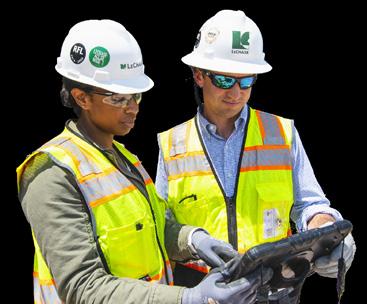


At LeChase, our reputation for integrity, safety and quality has earned us the privilege of building projects – large and small – that continue to shape the future of Sullivan County. Whether a project is in healthcare, K-12, higher education, commercial, manufacturing, hospitality or housing, we are proud to support efforts that make the community an even better place to live, work and learn.

Sullivan County Partnership for Economic Development | 845.794.1110 | SCPartnership.com 41
Power Your Small Business with Energy Tax Credits, Incentives, and More
Jonathan Rouis, CPA Partner

RBT CPAs, LLP
51 Sullivan Street
Wurtsboro, NY 12790
845-888-5656
If you have been thinking about upgrading your business facility or vehicle, there is no better time than the present. Today’s tax laws and resources can help your small business reduce energy and maintenance costs; create a more comfortable and productive work environment; reduce your carbon footprint; and enhance your brand.
The Federal Inflation Reduction Act (IRA) provides tax credits for operating more efficiently and cleaner. New York state offers tax credits and numerous clean-energy programs. Add to that the incentives, special services, and

financing available through energy-related providers and your small business may find significant energy and monetary savings. (Of course, eligibility criteria apply.) For example…
For new construction or a retrofit (addition of something new to something old) of a qualifying energy efficient commercial building. With the IRA’s Energy Efficient Building Deduction (a.k.a. 179d), when construction or updates reduce annual energy and power costs by at least 25%, and prevailing wage and apprenticeship requirements are met, your business
Sullivan County Partnership for Economic Development In the Know | Summer 2023 42
can receive a deduction of $2.50/square foot. For each additional percentage that annual energy and power costs are reduced, the deduction increases by $.10, with the maximum deduction being $5/square foot (up from $1.88 in 2022).
Lighting. One of the easiest ways to save energy (and money) is to upgrade to energy efficient lighting. Some LED solutions can save you up to 90% on energy related costs and some solutions can last up to 25 years without replacement. What’s more, if you make this part of new construction or a retrofit, upgrades may qualify for IRA deductions.
Building envelope. Everything that goes into creating the shell of your building – walls, roofing, foundation, doors, and windows – is considered part of the building envelope. Improve temperature control, air quality,
and condensation with building envelope updates like weatherstripping windows and doors, increasing insulation, and air leak sealing. Not only will your building be more comfortable, but you can also lower energy and operating costs, and possibly take advantage of IRA deductions.
Heating, Ventilation and Air Conditioning (HVAC). Upgrading to a high-efficiency system can improve energy performance, especially if current equipment is more than 10 years old or malfunctioning. New clean heating and cooling systems not only save on energy, but also help your business reduce its carbon footprint. Plus, they have longer lifespans than older systems and provide more accurate temperature control. Make this part of a new construction project or retrofit to qualify for IRA deductions.
Solar. One of the cleanest energy options is solar. Businesses that adopt it can save up to 30% on installation costs with IRA tax credits, while potentially reducing energy costs by 75%. If interested, get started soon as these tax credits begin to phase out in 2033. In addition, New York offers solar tax credits (for the lower of $5,000 and 25% of installation costs). If your business is eligible for both the IRA and NY credits, you can reduce installation costs by more than 50%.
Vehicles. With the IRA’s Clean Vehicle Tax Credit, your business may qualify for up to a $7,500 credit for a plug in EV or fuel cell electric vehicle (vehicles 14,000 pounds and over may qualify for up to a $40,000 credit). In addition, for cars, you may qualify for a $2,000 rebate under the Charge NY initiative, bringing your total potential tax credit to $9,500.
If you’re not sure where to start, numerous resources (including energy audits) are available through New York State and local utility providers (i.e., NYSEG, Orange & Rockland, or Central Hudson). Learn more about the many programs available to help your business operate greener and cleaner at https://www.nyserda. ny.gov/PutEnergyToWork/Industry-Energy-Solutions/ Small-Business.

Power Your Small Business with Energy Tax Credits, Incentives, and More Sullivan County Partnership for Economic Development | 845.794.1110 | SCPartnership.com 43
Report predicts possible power shortages if aging fossil fuel plants close too soon.

Study looks at power needs in NYC and challenges of moving electricity around the state.
Rick Karlin

Times Union
rkarlin@timesunion.com
518-454-5758
@RickKarlinTU
Republished with permission of Times Union
NORTH GREENBUSH — The organization that oversees New York’s power grid recently said that without extensive changes some of the aging fossil fuel power plants in New York City may have to remain open after their scheduled closing date of 2025 in order to avoid potential power outages. The report “reflects the extraordinary challenges of the grid in transition,” said Zach Smith, vice president of System and Resource Planning at the New York Independent System Operator.
“The reliability of the electric system is essential to the health and safety for all New Yorkers as well as the state’s economy,” he added.
“The NYISO will now work to identify solutions to the reliability need identified in New York City.”
Sullivan County Partnership for Economic Development In the Know | Summer 2023 44
NYISO helps control the transfer of electricity across the state’s grid through a web of power lines. They also issue reports predicting future needs and potential shortfalls on the power grid. The report found that New York City could be in danger of power interruptions by 2025, especially if the phasing out of aging “peaker” plants proceeds as planned. Peaker plants are fossil fuel power plants located across that metropolitan area that are fired up in times of high demand including during summer heat waves. The plants are supposed to be phased out in favor of newer, cleaner sources of power such as solar and wind farms upstate.
The trouble is there are bottlenecks in getting the upstate power to where it is needed downstate, which could lead to the predicted shortages. NYISO’s report noted that the Champlain Hudson Power Express, a transmission line under construction, would ease the shortages if it is finished on schedule. They have planned to begin delivering power in 2026. The 2019 Climate Leadership and Community Protection Act calls for a carbon-free power grid by 2040, with 40 percent carbon-free electricity by 2030.But the transition could be difficult. For instance, the NYISO report predicts a deficit as large as 446 megawatts if the peaker plants close without sufficient energy sources to replace them.
One megawatt powers about 1,000 homes.
Those in the power industry said a recent report echoes what they have been saying all along: Cost overruns, COVID-19 delays and other snags have challenged the state’s ambitious timeline for moving to a carbon-free power grid. “The pace of play is not keeping up with pace of promises, and this report makes that clear,” said Gavin Donohue, president and CEO of the Independent Power Producers of New York, a trade group of power plant operators, including fossil fuel plants. “There have been repeated cautions from the NYISO regarding grid reliability, and this report highlights the reality that generator retirement cannot outpace the addition of new generation,” he added.
Environmentalists, though, said the report highlights the need to move faster in building a green energy infrastructure. “They are raising the flag. Now it’s on the back on the utilities and on the state to really step up and find some solutions here,” said Conor Bambrick, policy director for Environmental Advocates NY. “We can’t continue to rely on those failed processes of the past.”
In addition to the CLCPA goals, the state Department of Environmental Conservation in 2019 enacted emission rules for peaker plants. As a result, NYISO noted, some 1,027 megawatts of power production have shut down. The rules call for another 509 megawatts from fossil fuel plants to come offline in New York City. In addition to the CO2 created by fossil fuels, the older plants emit particulates and nitrogen oxides, and are especially harmful in densely populated locations like the greater New York City area. Many of the older plants also are in poor neighborhoods where Black and brown residents predominate.

Electricity demand in New York City is expected to grow, since the CLCPA calls for the electrification of heating and cooking and more use of electric vehicles. While reducing greenhouse gases, that move will increase the demands on the electric grid, both in the city and across the state. By itself, upstate New York has adequate electricity and most of it is carbon-free thanks to the longstanding hydroelectric plants along the St. Lawrence River and Niagara Falls and nuclear plants in northern New York. The NYISO report does, however, acknowledge the need for more green energy in the upstate region, given developments there. Namely, they reference a large computer chip plant that Micron Technology is planning north of Syracuse and a hydrogen fuel plant planned by Air Products in Massena near the Canadian border.
Rick Karlin covers the environment and energy development for the Times Union. Has previously covered education and state government and wrote about natural resources and state government in Colorado and Maine. You can reach him at rkarlin@timesunion.com or 518-454-5758.
Sullivan County Partnership for Economic Development | 845.794.1110 | SCPartnership.com 45
The Partnership had a Busy Spring & Summer Events Calendar!



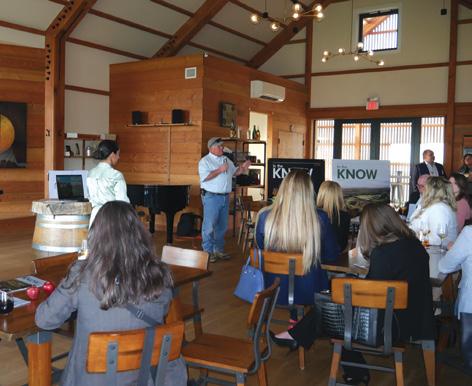


Event sponsorship is a great way to showcase your business and message in front of a captive audience. Turn the page to take advantage of our upcoming opportunities at our 29th Annual Meeting and Awards Dinner on October 5th honoring the Walter A. Rhulen award winners: Murray and Ellen Bresky, and board member Amanda Gesztesi from Paychex with the Distinguished Service Award.
Quarterly Meeting Seminary Hill
April 20, 2023
Sullivan County Partnership
Economic Development In the Know | Summer
46
for
2023

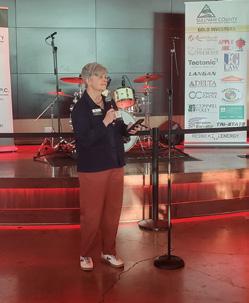





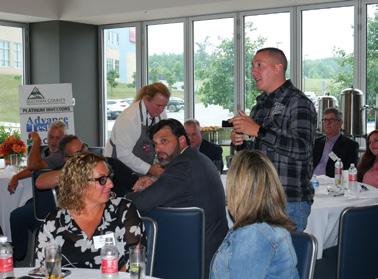
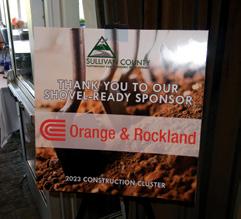
Construction Cluster Networking Event Cellaio Steakhouse, Resorts World Catskills June 28, 2023 Women in Business Doubletop, Resorts World Casino Sullivan County Partnership for Economic Development | 845.794.1110 | SCPartnership.com 47
29TH ANNUAL MEETING & AWA R DS SPONSORSHIP OPPORTUNITIES
THURSDAY, OCTOBER 5 • 5:30–8:30PM
Resorts World Catskills • 888 Resorts World Drive • Monticello, NY 12701

Lanyard Sponsor - $5,000 (Exclusive 1)
“The Ultimate Visibility for your company”
This is a “can’t miss” opportunity as each attendee will be wearing your logo around their neck as they eat, drink and stare at nametags trying to remember everyone’s name. (This is the ONLY sponsorship that includes a tradeshow booth to display your marketing materials and any giveaways prominently)
• 7 tickets
• Branded Lanyards for all attendees
• Exclusive Table Display for promotional materials and giveaways
• Dedicated Signage at check-in table
• Half Page Ad in Annual Meeting Program
• Recognition in electronic journal (5 slides)
• Logo on sponsorship banner and website event page
• Logo in Annual Report
• Recognition on all social media platforms
Tommy Gun Drink Cart Sponsor - $4,000 (Exclusive 1)
Don’t wait to grab this popular sponsorship
— It WILL sell out!
Our cool friend Dwayne will be outside on the patio for his 3rd straight year, serving locally brewed and distilled cocktails from his “Little Tommy Gun” old-fashioned drink cart. (His Irish accent is just a bonus!)
• 2 tickets
• Branded napkins with company logo
• Half Page ad in Annual Meeting Program
• Recognition in electronic journal (5 slides)
• Dedicated signage
• Logo on sponsorship banner
• Logo on website event page
• Logo in Partnership Annual Report
• Recognition on all social media platforms
Only 200 balloons will be sold with one holding the ticket to our amazing grand prize package donated by Resorts World Catskills worth $1500.



Balloons can be purchased in advance for $25 each along with your event ticket. Winner will be revealed at the dinner. (must be present to win).

continued...
our sponsor with our “Pick your Pop” raffle. Overnight Stayina KingSuite $300 Restaurant Credit A foursome of Golf at the NEW Monster Golf Course Grand Prize Package Worth $1500
$185 •
For
info, to
or
cassaro.jen@scpartnership.com or
online at SCPartnership.com SPECIALTY SPONSORSHIPS NOT INCLUDED IN INVESTOR BENEFITS
Sullivan County Partnership for Economic Development In the Know | Summer 2023 48
Help
Ticket prices for SCP Members
Non-Members $215
more
sponsor, or to RSVP, call (845) 794-1110
email
register
SOLD!
Cocktail Reception Sponsor - $3,500
This one speaks for itself – “The drinks are on you!” Open bar during the cocktail hour between 5:30-6:30. Everyone loves a good drink benefactor so BE THAT company!
• 2 tickets
• Branded fold-over card on all cocktail tables and on the bar
• Dedicated signage throughout cocktail hour
• Recognition in electronic journal (5 slides)
• Logo on sponsorship banner
• Logo in Annual Meeting Program
• Logo on website event page
• Logo in Partnership Annual Report
• Recognition on all social media platforms
Dinner Wine Service Sponsor - $3,000 — NEW!
“Bottle of Red, Bottle of White…..”
Red and white wine will be served at each table with dinner, compliments of your company, and complete with a toast from the podium, thanking you for adding some class to the event with the “vin de table.”
• 2 tickets
• Event Kickoff toast from the Podium
• Dedicated signage on every table arrangement
• Logo in Annual Meeting Program
• Logo on sponsorship banner and website events page
• Recognition in electronic journal (5 slides)
• Recognition on all social media platforms
Dinner Program Sponsor - $2,000 (Exclusive 1)
“Read all about it!”
What’s the first thing you do when you get to your table... you read the program! Snag the inside cover of our 36-page program, featuring our honorees, and company ads.
• 1 ticket
• Full inside page cover ad in Annual Meeting
• Prominent logo in annual meeting program
• Recognition in electronic journal (3 slides)
• Logo on sponsorship banner
• Logo on the website event page
• Logo in Partnership Annual Report
• Recognition on all social media platforms
Platinum - $4,500
• 6 tickets
• Full Page Ad in Annual Meeting Program
• Company Highlight Eblast
• Logo on Sponsorship Banner
• Logo on the website event page
• Logo in Annual Report
• Recognition in Electronic Journal (7 slides)
• Recognition on all social media platforms
Gold - $2,500
• 3 Tickets
• Half Page Ad in Annual Meeting Program
• Company Highlight Eblast
• Logo on Sponsorship Banner
• Logo on the website event page
• Logo in Annual Report
• Recognition in Electronic Journal (5 slides)
• Recognition on all social media platforms
Silver - $1,500
• 2 tickets
• Logo on Sponsorship Banner
• Logo in Annual Meeting Program
• Logo on the website event page
• Logo in Annual Report
• Recognition in electronic journal (3 slides)
• Recognition on all social media platforms
Bronze - $900
• 1 ticket
• Logo on Sponsorship banner
• Logo in Annual Report
• Listing in Annual Meeting Program
• Listing on the website event page
• Recognition in Electronic Journal
• Recognition on all social media platforms
Supporter - $500
• Recognition in Electronic Journal
• Listing in Annual Meeting Program
• Listing on the website event page
• Listing in Partnership Annual Report
• Recognition on all social media platforms
Annual Meeting Dinner Program Advertising: “Put it on paper!”
Our dinner program is a great way to congratulate the award winners or advertise your company in front of 300 guests.
Full Page: 5.5”W x 8”H - $300
• Half Page: 5.5”W x 4.25”H - $150
• Premium Full Page Back Cover - $600
Design & Set Up Fee (If applicable) - $75
Please e-mail high-res, full color PDF, PNG or JPEG files and logo by September 12 to: Vanessa McPhillips: vanessa@scpartnership.com
Sullivan County Partnership for Economic Development | 845.794.1110 | SCPartnership.com 49
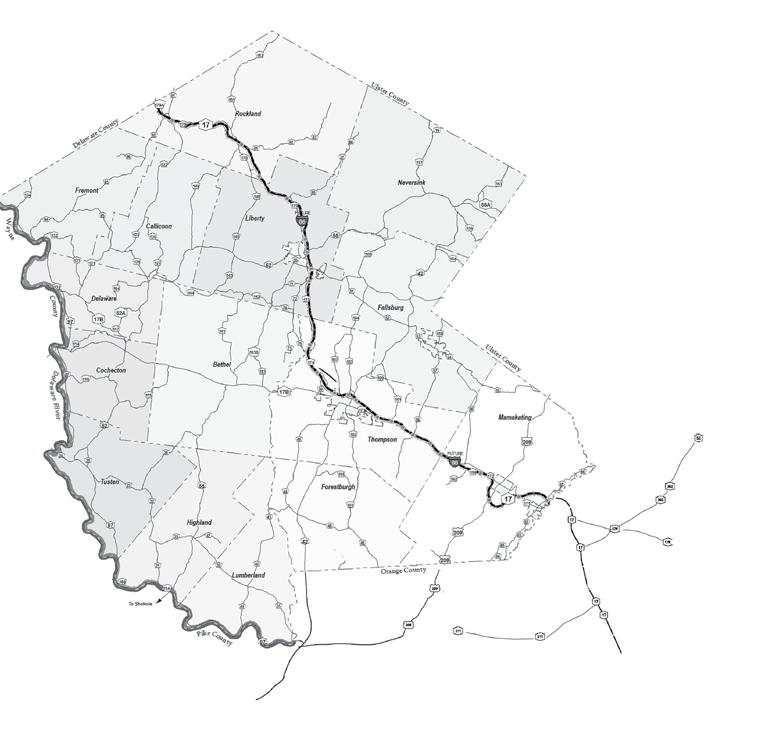













4 Monticello Ferndale Port Jervis Goshen Middletown New Windsor Newburgh Wurtsboro Narrowsburg Poughkeepsie Pleasant Valley Honesdale Pennsylvania Investors on the Map 2 11 14 12 13 5 6 10 14 8 9 1 BERGER ENGINEERING AND SURVEYING PLLC 3 7 Sullivan County Partnership for Economic Development In the Know | Fall 2022 50
Ever Wonder Where Our Investors are Located?
1 Atlas Security Services Inc. AtlasSecurityServices.us
845-742-6987
2002 Rt 17M Goshen, NY 10924
2 Barbanti Group Realty Barbanti.com
845-292-2800
17 North Main St Liberty, NY 12754
3 Berger Engineering and Surveying PLLC
BergerEngr.com
845-471-7383
100 Fulton Ave
Poughkeepsie, NY 12603
4 Bold Gold Media Group, LP BoldGoldMedia.com
570-253-1616
575 Grove Street Honesdale, PA 18431
5 Catania, Mahon & Rider, PLLC cmrlaw.com
845-565-1100
641 Broadway Newburgh, NY 12550
6 Comparion Insurance Agency/Liberty Mutual ComparionInsurance.com
845-594-8377
10 Masten Lake Ct. Wurtsboro, NY 12790
7 Consigli Construction Co., Inc. Consigli.com
845-707-3704
199 West Road Suite 100 Pleasant Valley, NY 12569
8 Dillon & Semenovich Inc. dillonsemenovich.com
845-800-9454
69 1/2 Watkins Avenue Middletown, NY 10940
9 Keller Williams Hudson Valley United KellerWilliamsUnited.com
845-649-1055
9 Bert Crawford Road Middletown, NY 10940
10 NVS Land LLC/Chapin Estates ChapinEstate.com
845-583-6500
PO Box 338 Bethel, NY 12720
11 Pyramid Brokerage Co.
845-787-1375
356 Meadow Avenue, 2nd Floor Newburgh, NY 12550
12 River Reporter RiverReporter.com
845-252-7414
93 Erie Ave Narrowsburg, NY 12764
13 Seminary Hill SeminaryHill.co
845-701-5031
43 Wagner Lane Callicoon, NY 12723
14 Standback GC, LLC StandbackGC.com
845-500-3712
1161 Little Britain Rd New Windsor, NY 12553
14 Van Etten Oil Company VanEttenOil.com
845-794-5511
79 St. John St. Monticello, NY 12701
PyramidBrokerage.com
From Honesdale, PA to Poughkeepsie, NY, they’re not just from Sullivan County! Each issue, we’ll be calling out members from all over the map. Sullivan County Partnership for Economic Development | 845.794.1110 | SCPartnership.com 51
2023 UPCOMING EVENTS

29th Annual Meeting & Awards Dinner
Thursday, October 5 5:30pm - 8:30pm


Resorts World Catskills

Holiday Gathering
Thursday, December 14 5:30pm - 8pm
Location TBD
Don’t wait to grab your sponsorships – Check out our updated media kit and see what opportunities will fit your company. Contact Jen Cassaro at 845-794-1110 to secure your sponsorship today!

EXPERIENCE A WORLD OF WINNING
RWCatskills.com GAMBLING PROBLEM? SCAN THE CODE OR CALL 877-HOPENY OR TEXT HOPENY (467369)*. MUST BE 21 OR OVER TO GAMBLE. *STANDARD RATES APPLY.
Visit








 By John C. Cappello, Esq., Partner (left) and Isabelle Hayes, Legal Intern (right) — J&G Law, LLP
By John C. Cappello, Esq., Partner (left) and Isabelle Hayes, Legal Intern (right) — J&G Law, LLP
































































 By Justin DePhillips, Generational Modular Group
By Justin DePhillips, Generational Modular Group






 Photo credit: Brad Dixon
Photo credit: Brad Dixon




 By Ron Kamen Earth Kind Energy Consulting
By Ron Kamen Earth Kind Energy Consulting
















































